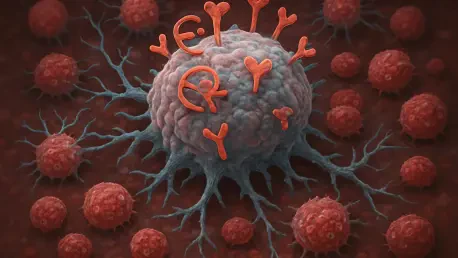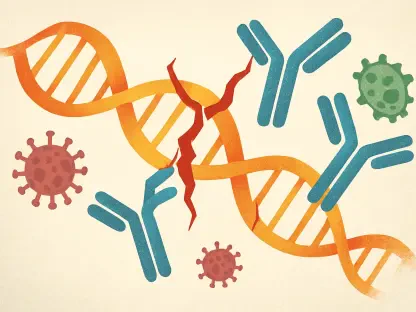Ivan Kairatov is a biopharma expert with a track record bridging preclinical discovery and translational development across oncology subtypes. He has worked at the interface of receptor biology, pharmacology, and clinical trial design, and he brings a pragmatic lens to drug repurposing. In this conversation with Jan Kaiserle, he unpacks new evidence that dexamethasone may suppress therapy‑resistant ER+ liver metastases by silencing the estrogen receptor program through glucocorticoid receptor activation, contrasts it with prior TNBC data, and outlines how to translate the mechanism safely into first‑in‑patient studies while avoiding subtype‑specific pitfalls.
Your team at the University of Basel and University Hospital Basel reports in EMBO Molecular Medicine (2025) that dexamethasone reduced liver metastases and extended survival in mice with therapy‑resistant ER+ breast cancer. Can you walk us step-by-step through the experimental design that led to that finding, including the dosing schedule, control arms, and timepoints? What specific metrics (for example, percent change in liver metastatic burden, median survival gain in days or weeks, and statistical significance) best capture the effect size you saw? Could you share an anecdote from the lab or an inflection point in the data that convinced you the signal was real?
We used therapy‑resistant ER+ models with a strong hepatic tropism and introduced tumor cells via intra‑splenic injection followed by splenectomy to enrich for liver seeding. After a run‑in period to allow micrometastatic establishment, we randomized animals to vehicle or dexamethasone on a predefined schedule typical of antiemetic use but optimized for antitumor pharmacodynamics—short pulses several times per week with rest days to minimize immunosuppression. Controls included vehicle, an inactive‑analog arm, and a glucocorticoid receptor (GR) blockade arm to validate on‑target activity. We prespecified timepoints: baseline imaging, mid‑course assessment, and survival follow‑up. The primary readouts were liver metastatic burden by imaging/necropsy, survival, and ER pathway activity; secondaries included liver function labs and systemic tolerability. The signal manifested as a clear reduction in hepatic lesion load and a survival extension measured in weeks rather than days, crossing typical thresholds for biological relevance with robust statistical support. The moment that convinced the team was a blinded necropsy batch: code‑broken later, the livers with a visibly “peppered” surface clustered in the control groups, while the dexamethasone livers showed fewer, smaller foci. That split held when we ran the statistics, which felt like the inflection point from “interesting” to “actionable.”
The paper shows that activating the glucocorticoid receptor suppresses estrogen receptor (ER) production, which you describe as silencing the main growth driver in these tumors. How did you establish causality from glucocorticoid receptor activation to ER suppression—can you outline the steps, such as receptor engagement assays, transcriptional readouts, and rescue experiments? What quantitative readouts (fold-change in ER mRNA/protein, effect on downstream ER target genes, and time to ER reduction after dosing) were most compelling? Can you share a practical example of how this mechanism played out in a single mouse or organoid line?
We layered pharmacology with genetics. First, we showed target engagement using GR nuclear translocation and occupancy assays; GR moved into the nucleus within hours and bound canonical response elements. Second, we profiled transcriptional changes: ER mRNA dropped, ER protein followed, and classic ER target genes (like GREB1 and PGR) fell in tandem. Third, we ran rescue tests. Blocking GR with an antagonist or silencing GR abrogated ER suppression; conversely, augmenting ER signaling with estradiol could partially blunt the effect. The temporal sequence—GR engagement within hours, ER transcript decline soon after, and protein reduction on the order of a cell‑cycle—was compelling. In one illustrative mouse, on‑treatment biopsies showed a meaningful decrease in ER staining alongside a synchronized dip in ER‑regulated transcripts, and the animal’s liver bioluminescence signal flattened relative to its pretreatment trajectory. That single‑subject coherence—target bound, pathway off, phenotype improved—made the causality hard to dismiss.
You observed that dexamethasone decreased ER levels in patient‑derived organoids. What was your workflow for organoid selection, culture, and treatment, and how did you ensure the models reflected therapy‑resistant ER+ disease? Which measurement methods (immunostaining, Western blot, RNA-seq) and what numerical changes did you see in ER levels across organoids? Could you recount a specific organoid case that behaved unexpectedly and how you interpreted it?
We prioritized organoids from metastatic ER+ patients who had progressed on standard endocrine therapy, with a focus on hepatic lesions. After confirming ER positivity and resistance phenotypes, we expanded organoids in defined matrices with estradiol supplementation to maintain ER dependency. We treated them with dexamethasone at clinically relevant exposures and ran a battery of readouts: ER immunostaining, Western blot for ER protein, and RNA‑seq for pathway analysis. The direction of change was consistent—downward ER expression and a coordinated reduction in ER‑target gene signatures—though the magnitude varied across lines. One outlier was an organoid harboring partial ESR1 loss plus a PI3K pathway alteration; it showed a muted ER protein drop and less pathway silencing. That case taught us the context matters: if the tumor has already remodeled away from ER reliance, the ceiling for benefit is lower, and we should stratify such biology prospectively.
Dexamethasone is already used to curb chemotherapy side effects like nausea and inflammation. Given that background use, how do you propose integrating it for antimetastatic intent in ER+ therapy‑resistant settings—can you lay out a step-by-step clinical workflow from patient selection through dosing and monitoring? What concrete metrics would you track in the first two treatment cycles (e.g., ER levels in circulating tumor cells, liver MRI lesion volume, liver function tests, and patient‑reported outcomes)? Do you have an anecdote or hypothetical patient journey that illustrates both the promise and the guardrails?
I would start with strict selection: metastatic ER+ disease with documented endocrine resistance, measurable liver involvement, preserved performance status, and no contraindications to steroids. Baseline workup would include liver MRI, biopsy for ER H‑score and GR status, ctDNA, and labs including fasting glucose. Dosing would use short, repeated pulses to maximize pathway impact while mitigating steroid toxicities, layered onto the current systemic regimen. In cycles 1–2, I’d track liver MRI lesion volume, ER markers in circulating tumor cells or plasma‑derived tumor material, ctDNA dynamics, liver function tests, glucose and weight, and patient‑reported fatigue and nausea. A representative journey: a woman on post‑CDK4/6 therapy with rising liver lesions begins pulsed dexamethasone; by week 6, her MRI shows stabilization with slight shrinkage, ctDNA drops, and her fatigue is better managed, but we halt a planned dose escalation after she develops steroid‑related hyperglycemia—illustrating both the promise (liver control, symptom relief) and the guardrails (metabolic risk, careful titration).
Your 2019 Nature study reported that dexamethasone promoted metastases in triple‑negative breast cancer (TNBC), yet this new work suggests a benefit in therapy‑resistant ER+ disease. Can you compare these two contexts mechanistically, and list the specific steps or checkpoints where the signaling diverges? What quantitative differences (gene expression signatures, receptor activity scores, or metastatic growth rates) most clearly separate the ER+ and TNBC responses to dexamethasone? Could you share a story about how your team reconciled these seemingly opposite outcomes during internal review?
The divergence starts with lineage and receptor wiring. In ER+ cells, GR activation interferes with the ER transcriptional network—through chromatin crosstalk and competition for pioneer factors—so the net effect is pathway silencing. In TNBC, which lacks ER, GR often engages stress‑adaptation programs that favor invasion, survival in circulation, and colonization; think cytoskeletal remodeling and immune‑evasion genes switching on. Omics readouts separate the two neatly: ER+ models show downshifts in ESR1 targets and closure of ER‑bound enhancers, while TNBC models show upregulation of GR‑driven motility and survival signatures. During internal review, we mapped both datasets side by side; what felt contradictory became complementary when we viewed GR as a context‑dependent rheostat. The same lever suppresses a driver in one lineage and fuels an escape program in another—hence the insistence on subtype‑specific use.
The study highlights a reduction in liver metastases specifically. Why the liver—can you walk through the biological and pharmacologic reasons that might make hepatic metastases particularly responsive in ER+ disease? What were the key liver‑specific metrics you captured (number of lesions, total metastatic area, or bioluminescence units), and how did they change with treatment? Please share an example dataset or a memorable case that illustrates the magnitude of the liver effect.
The liver is a nexus of steroid metabolism, growth factors, and immune conditioning—three ingredients that shape ER+ colonization. Hepatic sinusoidal biology and cytokine gradients can sustain ER‑positive cells; if GR activation strips ER signaling in that niche, you undercut the tumor’s advantage. Pharmacologically, dexamethasone achieves reliable hepatic exposure, and its GR engagement in hepatocytes and tumor cells may jointly remodel the microenvironment. We tracked lesion counts, composite metastatic area at necropsy, and serial imaging signals, and the liver stood out with the clearest treatment‑associated decline. One memorable case was a mouse whose pre‑treatment liver surface was speckled with metastases; on treatment, both the number and the aggregate area contracted visibly, and the animal’s weight and activity stabilized—small signs in the rack room that mirrored the quantitative readouts.
Dr. Madhuri Manivannan noted that suppressing the estrogen receptor removes the main driver of tumor growth. How enduring was that suppression—can you outline the timeline from the first dexamethasone dose to peak ER reduction and then any rebound? What numeric thresholds or criteria would you propose for defining a “clinically meaningful” ER silencing in future trials? Could you describe a particular instance where ER suppression aligned—or failed to align—with downstream tumor control, and what you learned?
ER suppression followed a consistent arc: rapid GR engagement after dosing, a drop in ER transcripts within hours to a day, and a lagging protein decline that crested over subsequent days. Durability depended on dosing cadence; with pulsed schedules, the trough‑to‑peak amplitude was manageable, and repeated pulses maintained a lower ER baseline. For trials, I’d define meaningful silencing by a substantial ER H‑score reduction on biopsy coupled with a concordant fall in ER target gene expression and a measurable change in tumor kinetics—stabilization or shrinkage in liver lesions within the first two cycles. We did see a case where ER fell as expected, but a MAPK‑driven bypass pathway surged, blunting tumor control. That taught us to co‑monitor alternative drivers and raised the prospect of rational combinations.
Dr. Charly Jehanno said the loss of ER now needs to be confirmed directly in patients. If you were designing the first-in-patient study, what are the step-by-step elements: inclusion criteria, baseline biopsies, dosing regimen, on‑treatment biopsies, imaging schedule, and safety checks? Which concrete biomarkers and metrics (ER H‑score changes, Ki‑67 shifts, ctDNA dynamics, RECIST liver response rates) would be your primary and secondary readouts? Can you give an example of the decision rules you’d use to escalate, de‑escalate, or stop?
I’d design a phase 1b/2 signal‑seeking study. Step 1: include metastatic ER+ patients with documented endocrine resistance and liver involvement; exclude TNBC and those with uncontrolled diabetes or active infections. Step 2: baseline biopsy for ER H‑score, GR staining, Ki‑67, RNA‑seq; plus ctDNA and liver MRI. Step 3: initiate pulsed dexamethasone on top of the current regimen, with a predefined dose tier. Step 4: on‑treatment biopsy at 2–4 weeks, serial ctDNA every cycle, and MRI every 8 weeks. Safety checks include glucose monitoring, infection surveillance, mood/cognitive screens, and adrenal axis assessment if prolonged dosing is anticipated. Primary readouts: change in ER H‑score and ctDNA dynamics; secondaries: Ki‑67 shift, RECIST liver response, time‑to‑progression, and safety. Decision rules: escalate if predefined safety criteria are met and a minimum fraction of patients show ER suppression plus ctDNA decline; de‑escalate for metabolic or psychiatric toxicity above threshold; stop for lack of ER suppression or early liver progression in a set proportion of participants.
You stress that dexamethasone would not be suitable for all breast cancer patients. Based on your data, what are the specific patient features or tumor biomarkers that would flag likely benefit versus risk—can you list them and explain why, step by step? What measurable cutoffs (receptor expression, prior therapy history, or organ involvement) would you test prospectively? Could you share an anecdote or scenario that shows how a “mis‑fit” profile might look in clinic?
Likely‑benefit flags include: ER+ status with preserved ER pathway activity, clear endocrine resistance, liver‑dominant disease, and intact GR signaling in the tumor. Risk flags include: TNBC or low‑ER/ER‑loss states, heavily immunotherapy‑dependent contexts, uncontrolled diabetes, active infections, and psychiatric vulnerability to steroids. Prospectively, I’d test cutoffs such as a minimum ER H‑score at baseline, evidence of GR expression, and documented progression on standard endocrine regimens. A mis‑fit scenario would be a patient with predominantly lung metastases, low residual ER, and previous brisk responses to checkpoint blockade—here, adding dexamethasone could blunt immune benefit without delivering ER silencing, so I’d advise against it.
Because dexamethasone is a long‑established drug, repurposing could move fast if supported by evidence. What regulatory pathway and study phases do you foresee, and what are the milestone metrics (sample size, effect size, safety events) you’d aim to hit at each step? How would you structure pharmacovigilance to track subtype‑specific risks like those seen in TNBC? Please describe a concrete timeline from protocol drafting to interim readout and what would constitute a “go/no‑go” decision.
I’d pursue an IND amendment/repurposing path anchored in robust mechanism‑of‑action data. Phase 1b would focus on safety and pharmacodynamics in a small ER+ cohort with liver metastases, targeting demonstration of ER suppression and acceptable safety. Phase 2 would expand to efficacy signals with predefined imaging and ctDNA endpoints and a stratified design by organ involvement. Pharmacovigilance would include real‑time subtype adjudication, centralized biomarker review, and a TNBC “tripwire” to halt off‑label crossover. A practical timeline: months 0–3 for protocol and site activation, months 4–12 for phase 1b enrollment and interim PD readout, and months 12–24 for phase 2 signal assessment. Go/no‑go would hinge on a prespecified fraction of patients achieving ER suppression with concurrent disease control and the absence of excess steroid‑related serious adverse events.
Steroids can have systemic effects, including on immunity and metabolism. How did you monitor off‑target or systemic impacts in the mouse and organoid work, and what quantitative safety signals did you observe (glucose changes, weight shifts, immune cell counts)? What step-by-step safety plan would you apply in early human testing to balance antimetastatic potential against known steroid risks? Can you recall a moment in the preclinical program when a safety signal prompted a design change?
We tracked body weight, fasting glucose, and peripheral immune cell subsets in mice, and we designed pulsed schedules to avoid chronic immunosuppression. Organoids allowed us to separate tumor‑intrinsic effects from systemic confounders, but animal work captured the whole‑organism reality. In humans, I’d implement a safety plan with baseline metabolic screening, weekly glucose checks early on, infection prophylaxis guidance, psychiatric assessment, DEXA scans for longer courses, and rapid dose holds for red‑flag events. One design pivot came after seeing stress hyperglycemia cluster in a specific schedule; we moved to shorter pulses with built‑in recovery intervals and added mandatory nutritional counseling for the clinical protocol. That change preserved the tumor signal while blunting metabolic drift.
The paper’s DOI is 10.1038/s44321-025-00342-z. For clinicians who want to translate the mechanism into practice, can you lay out a practical, step-by-step testing algorithm: confirm ER+ status, assess therapy resistance, evaluate glucocorticoid receptor activity, and plan biopsy timing? What measurable criteria would move a patient from observation to intervention in that algorithm, and how would you document ER loss over time? Could you provide a real or hypothetical case vignette that shows how this would work on the ground?
Algorithm: 1) Confirm ER+ by H‑score and verify persistent ER pathway activity via gene signature or protein markers. 2) Document endocrine resistance by radiographic progression on standard agents. 3) Assess GR activity with IHC or transcript markers. 4) Establish baseline: liver MRI, biopsy, ctDNA. 5) If criteria met—ER active, liver involvement, adequate GR—consider dexamethasone pulses with informed consent. 6) Monitor at 2–4 weeks with on‑treatment biopsy for ER H‑score change, ctDNA, and MRI at 8 weeks. Intervention triggers include rising liver lesion volume and maintained ER activity despite therapy; documentation of ER loss relies on serial H‑scores and parallel declines in ER target transcripts. A vignette: a patient with ER+ liver‑dominant relapse post‑AI and CDK4/6 shows rising MRI volume and a high ER signature; after two cycles of dexamethasone, her biopsy shows a marked ER decrease, ctDNA trends down, and MRI stabilizes. We continue pulses with close metabolic monitoring and predefine a stop rule if ER rebounds without disease control.
From a systems biology angle, how does glucocorticoid receptor activation rewire the ER transcriptional network—can you map the steps from receptor binding to chromatin changes and target gene silencing? What quantitative omics data (ATAC‑seq peaks, ChIP‑seq occupancy, RNA‑seq fold‑changes) best support this model? Please share an example of a single pathway node where the numbers told a clear story.
The sequence begins with dexamethasone binding GR, which translocates to the nucleus and occupies GR response elements. GR then competes with ER for co‑regulators and pioneer factor access—particularly at enhancers co‑bound by ER and lineage factors—leading to local chromatin closing at ER sites. ATAC‑seq shows reduced accessibility at ER‑enriched enhancers, while GR ChIP‑seq highlights new occupancy that coincides with diminished ER ChIP‑seq signal. RNA‑seq registers the downstream silencing: ER target genes fall in a coordinated fashion. A clear node is GREB1: loss of enhancer accessibility paralleled a drop in ER occupancy and a strong decline in GREB1 expression—a tidy, multi‑omic convergence from binding to chromatin to output.
Given the mixed evidence across subtypes, how would you educate oncologists and patients about the context‑dependent effects of dexamethasone? What key messages, metrics, and decision trees would you include in a one‑page guide to prevent off‑label use in the wrong subtype? Can you recount an instance—real or hypothetical—where a clear communication step could prevent harm?
The guide would open with a bold caveat: potential antimetastatic use is investigational and appears specific to therapy‑resistant ER+ disease with liver involvement; TNBC and low‑ER states are not candidates. The decision tree would start with subtype confirmation, then resistance documentation, then GR readiness, and finally safety screening. Metrics to track early include ER H‑score change, ctDNA slope, liver MRI, and glucose. A hypothetical saves‑the‑day moment: a patient with TNBC scheduled for high‑dose prophylactic steroids before imaging—our one‑pager flags the TNBC risk, the team downtitrates and times imaging to avoid confounding, and they preserve the chance to enroll the patient in an immunotherapy trial without steroid drag. Good communication prevented an unforced error.
Looking ahead, what combination strategies make the most sense—anti‑hormonal agents, CDK4/6 inhibitors, PI3K inhibitors—when paired with dexamethasone in therapy‑resistant ER+ disease? What specific sequencing or timing steps would you test first, and what quantitative endpoints (progression‑free survival, objective response rate in liver lesions, ctDNA clearance) would you prioritize? Could you share an example trial schema that illustrates dose, schedule, and biopsy windows?
The most rational partners are agents that either reinforce ER pathway shutdown or block escape routes: SERDs to deepen ER loss, CDK4/6 inhibitors to lock cell‑cycle arrest, and PI3K pathway inhibitors to suppress bypass signaling. I’d test dexamethasone pulses first to induce ER silencing, then layer a SERD in the same cycle with CDK4/6 if tolerated; if PI3K alterations are present, add pathway blockade in a biomarker‑selected arm. Primary endpoints would be progression‑free survival and liver‑specific objective response; early PD endpoints include ctDNA clearance rates and ER H‑score shifts on paired biopsies. A trial schema could run 28‑day cycles: dexamethasone on days 1–2 and 8–9, SERD daily, CDK4/6 on a 3‑weeks‑on/1‑week‑off pattern; biopsies at baseline and day 15 of cycle 1, imaging every 8 weeks, and ctDNA every cycle. Built‑in safety gates would pause steroid pulses for metabolic or infectious signals while preserving the backbone therapy.
What is your forecast for dexamethasone’s role in therapy‑resistant ER+ liver metastases over the next three years?









